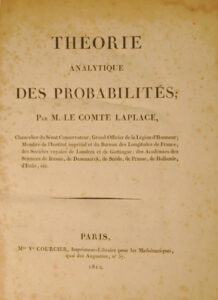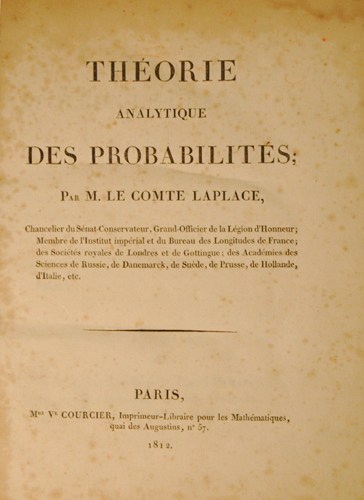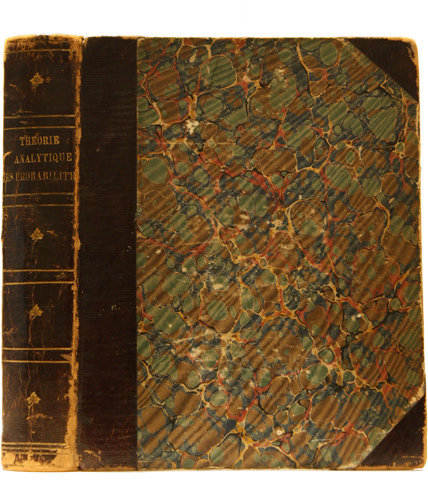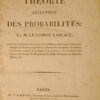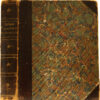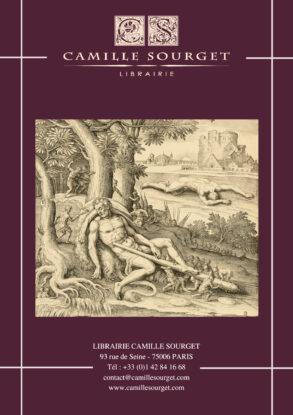Paris, Mme Ve Courcier, 1812 [-1820].
4 to [254 x 203 mm], (3) ff., 464 pp., (1) l. of errata, 34 pp., 50 pp., 36 pp. Some foxing Bound in contemporary aubergine straight-grained half-morocco, flat spine decorated with gilt fillets. Corners and joints rubbed. Binding worn.
First edition of one of the founding works of the theory of probability. DSB XV, 367-376; UC Berkely, First Editions of Epochal Achievements (1934), 12; Stigler, History of Statistics, pp. 146-148.
“The ‘Théorie analytique des Probabilités’ contains besides an introduction two books and four supplements: Book I. Du calcul des Fonctions génératrices; Book II. Théorie générale des Probabilités ; first supplement, composed in 1816. Sur l’Application du calcul des Probabilités à la philosophie naturelle ; second supplement, composed in 1817. Sur l’Application du calcul des Probabilités aux opérations géodésiques, et sur la Probabilité des résultats déduits d’un grand nombre d’observations ; third supplement, composed in 1819. Application des formules géodésiques de Probabilité à la Méridienne de France. It is in this publication that Laplace expounded his beautiful theory of the generative functions.” (Hoefer, Nouvelle biographie générale, 547).
“Pierre Simon Laplace was born in Normandy on the 23rd of March 1749 and died in Arcueil on the 5th of March 1827. He was so talented for analysis that he was called “the French Newton”; he paid particular attention to the great problem of universal gravitation and motion of the celestial bodies. Like Lagrange, he attained remarkable results in this field, proving the stability of the solar system and making notables discoveries, which were recorded in the reports of the Académie des Sciences from 1784 […]. In the ‘Théorie analytique’ (1812) Laplace gave a classical form to the calculation of probabilities.” (Dictionnaire des auteurs, III, 40).
Laplace who had carried out his first works about probabilities between 1771 and 1774 published his ‘Théorie analytique des probabilités’ in 1812. In this work Laplace gives decisive elements for the theory of probabilities, for which he is considered as one of the founders.
As a direct heir to Newton in the field of celestial mechanics, Laplace may also be considered as the heir of Pascal in the field of calculation of probabilities as thanks to his works this subject has acquired a new power.
“In the ‘theorie’ Laplace gave a new level of mathematical foundation and development both to probability theory and to mathematical statistics. ‘Theorie Analytique des probabilités’. First publication: Paris, Courcier, 1812. 465 pages. Print-run : 1200 copies. Pierre Simon Laplace published the first edition of ‘Théorie analytique’ in 1812, at the age of 63 years. It represented the culmination of a professional lifetime of concern for the topic, and all of its text consisted of reworked versions of his earlier work. Laplace’s prodigious abilities in the mathematical sciences were recognized early on, by his teachers in Normandy and by Jean d’Alembert in Paris when he was only 20.” (Landmark writings in Western Mathematics, 1640-1940, p.329). « Laplace has been called the ‘Newton of France’… He was the son of a small farmer in Normandy. Some rich neighbours recognized his talents and helped with his education. Arriving in Paris at the age of eighteen he met d’Alembert, who secured for him a position as professor of mathematics at the Ecole Militaire, and he soon became a member of the Académie des Sciences […] Laplace’s other mathematical work included the ‘Théorie Analytique des Probabilités’, 1812, and a treatise on the attraction of spheroids. Laplace’s co-efficients are important in the theory of attraction, hydrodynamics and electrical science.” (PMM, 252).
Precious copy of this fundamental work in the history of mathematics.
The present book is extremely rare on the market. Only one copy of this first edition appeared on the public market since over 30 years, the Honeyman copy which included only the first supplement and that was sold by Sotheby’s London in May 1980.
Only two copies complete with the supplements are recorded in French public institutions: at the Bibliothèque Sainte-Geneviève of Paris and at the Bibliothèque de Toulouse. The copy of this original edition preserved at the B.n.F. does not include any of the three supplements.
